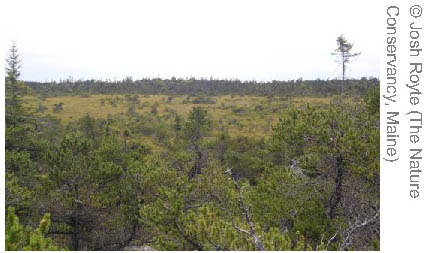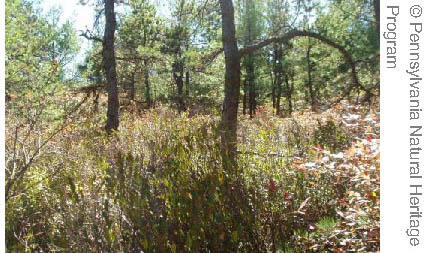The Northern peatland macrogroup consists of the following habitats:
Acadian Maritime Bog


Regional distribution:
ME. 5,235 total acres of habitat, of which 21.9% is conserved.
Description:
An acidic peatland dominated by dwarf-shrubs, sedges and peat-mosses, and occurring along the northern Atlantic Coast. When these form in basins, they develop raised plateaus with undulating sedge and dwarf-shrub vegetation. They also occur as "blanket bogs" over a sloping rocky substrate in extreme maritime settings. Species characteristic of this maritime setting include crowberry and baked-apple berry. Typical bog heaths such as sheep laurel, bog laurel, huckleberry, and Labrador tea are also present. The peat moss layer is extensive, with coverage usually close to 100%. The core distribution for this system is in the Canadian Maritimes, where there are some very large examples-- it is rare in the northeastern US.
Download the
pdf for this habitat for information about species, crosswalks to state names, and condition of this habitat.
Boreal-Laurentian Bog


Regional distribution:
ME, NY, VT. 45,394 total acres of habitat, of which 40.6% is conserved.
Description:
A raised peatland of near-boreal latitudes of the glaciated northeastern and north-central United States and adjacent Canada. Often more than 500 meters in diameter, they are dominated by low heath shrubs (sheep laurel, bog laurel, Labrador tea, leatherleaf) and patches of sedge and bryophyte lawns. Sparse to patchy black spruce and larch are also characteristic, with tree cover usually less than 25%. Typical forbs include sundews, pitcher plants, and several orchids. The accumulated peat forms a central surface that typically is over the water table (ombrotrophic) and displays concentric patterning. While the raised portion defines these bogs, fen vegetation is often present along the wetter perimeter.
Download the
pdf for this habitat for information about species, crosswalks to state names, and condition of this habitat.
Boreal-Laurentian-Acadian Acidic Basin Fen


Regional distribution:
MA, ME, NH, NY, VT. 401,390 total acres of habitat, of which 34.0% is conserved.
Description:
A sedge, grass, and dwarf-shrub dominated peatland of the northern part of the glaciated Northeast. Almost intermediate between a marsh and a bog, these fens develop in relatively shallow basins with nutrient-poor and acidic conditions, and may form a floating peat-based mat over water. The substrate is (generally deep) peat moss, and vegetation typically includes patches of graminoid herbs: coast sedge, American woollyfruit sedge, tussock sedge, Billings' sedge, tawny cotton-grass. Dwarf-shrubs such as leatherleaf often dominate; stunted black spruce and larch may be present. Northernmost examples may show a distinctive pattern of ribbed fens, narrow low ridges with wetter pools or depressions between the ridges.
Download the
pdf for this habitat for information about species, crosswalks to state names, and condition of this habitat.
North-Central Interior and Appalachian Acidic Peatland


Regional distribution:
CT, MA, ME, NH, NJ, NY, PA, RI, VT. 83,789 total acres of habitat, of which 38.1% is conserved.
Description:
A dwarf-shrub peatland of small basins south of the coldest regions of the Northeast down to near the glacial boundary, where stagnated ice left coarse deposits and glacial depressions. Vegetation is dominated by heath shrubs and dwarf-shrubs (e.g., leatherleaf), with patches of sedges and forbs. . Some peatlands may have a sparse tree layer (black spruce, larch, pitch pine). Although these are often called bogs, because the glacial "kettleholes" and small basins they form in are generally closed (i.e., without inlets or outlets of surface water), in most cases they should technically be called fens (albeit nutrient-poor ones) because the vegetation remains in contact with the groundwater.
Download the
pdf for this habitat for information about species, crosswalks to state names, and condition of this habitat.